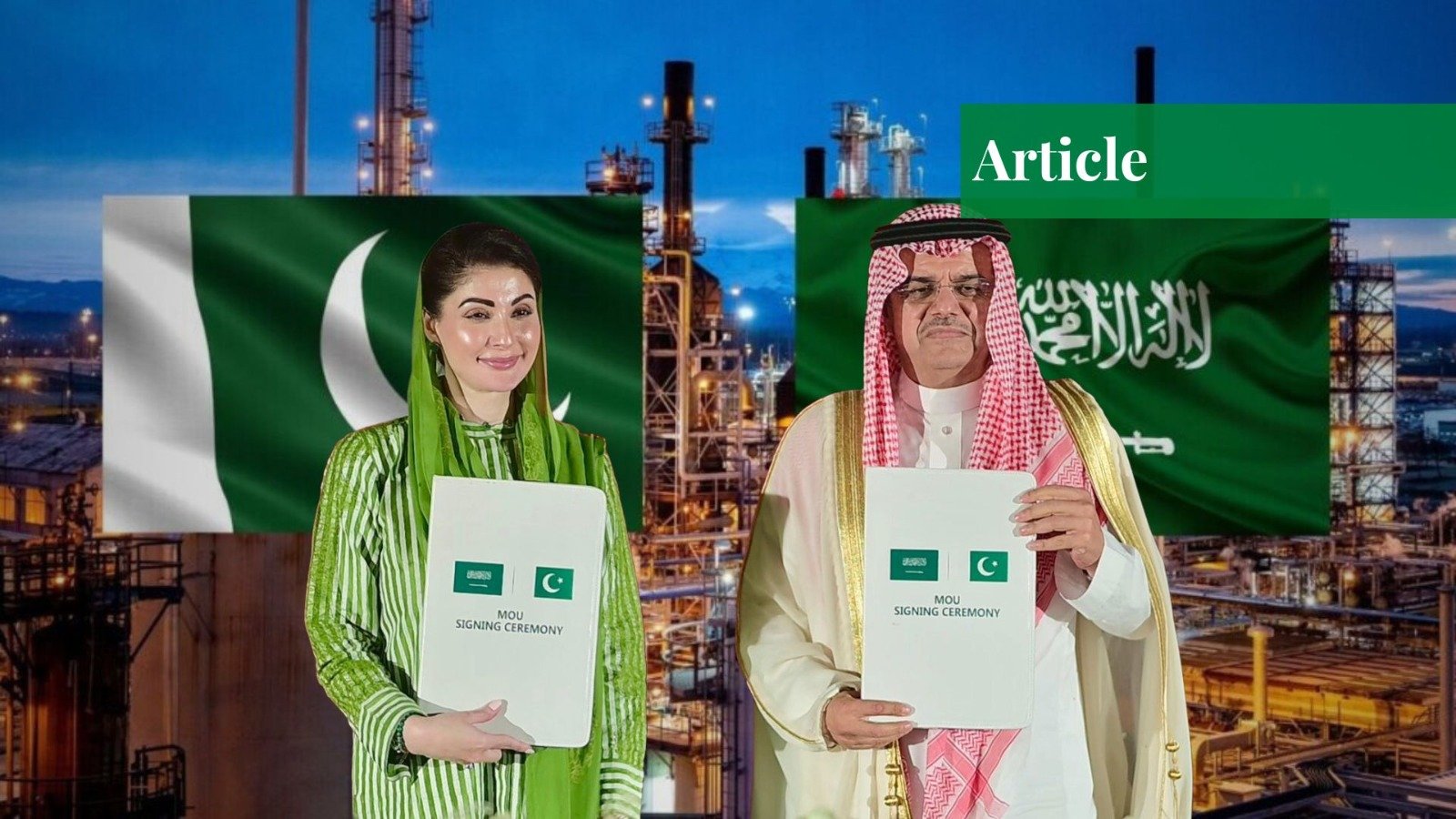The Utopian Promise
There’s something irresistibly cinematic about the idea: a new Saudi industrial city rising in Punjab, powered by Gulf capital and Pakistani labor, a shimmering symbol of brotherhood and ambition. The announcement last week from Lahore sounded almost utopian—ten years of tax and customs exemptions, a “Zero Time to Start” policy for investors, and promises of jobs, technology, and transformation. For a country perpetually chasing growth, it felt like hope had finally found an address. Yet, behind the optimism lies a quieter truth: this is still just an MoU, a memorandum of understanding—a handshake, not a contract.
To be fair, the announcement rests on real groundwork. Punjab’s government signed an MoU with the Saudi-Pakistan Joint Business Council to channel investments into special economic zones (SEZs), industrial estates, logistics, and real estate. Complementing this is the province’s new “Zero Time to Start” initiative—a fast-track regime meant to eliminate bureaucratic purgatory for foreign investors. Layered on top is Pakistan’s federal SEZ Act, which already guarantees a one-time duty exemption on capital goods and a ten-year income tax holiday for industrial developers and enterprises. Structurally, this is no empty slogan; the legal framework for incentives exists.
Politically, the deal carries momentum. After the recent Saudi-Pakistan defense pact, the two nations are arguably more aligned than they’ve been in decades. Riyadh’s Vision 2030 seeks to diversify beyond oil, and Pakistan’s industrial base—cheap labor, energy infrastructure, and proximity to Central Asia—offers a natural outlet for that diversification. Punjab’s pitch, in essence, is simple: you bring capital, and we bring capacity.
The economic logic holds. Industrial clusters, when executed well, multiply jobs, exports, and productivity faster than any other intervention. A Saudi-backed zone could channel billions into infrastructure and inject liquidity into Pakistan’s struggling manufacturing sector. It could also knit Pakistan tighter into the emerging web of Gulf-Asia supply chains, serving as a back-office and light-industrial complement to Saudi Arabia’s mega-projects like NEOM. In a best-case scenario, it becomes a CPEC 2.0 but led by private capital rather than state loans—a cleaner model for sustainable growth.
The Historical Hurdle: Converting MoUs to Outcomes
But the hard question remains: can Pakistan turn MoUs into measurable outcomes? Because historically, it hasn’t. The country’s economic landscape is littered with signed agreements that never made it past press conferences—zones without utilities, factories without roads, promises without paychecks. In that sense, this Saudi MoU is less an achievement than a test. It will measure Pakistan’s ability to deliver on its own policies rather than announce new ones.
The hurdles are tangible. Start with land and infrastructure. A genuine industrial city needs serviced land, clear title, and trunk infrastructure—roads, power, water, and waste systems—all delivered before investors arrive. Punjab has land banks and SEZ sites, but readiness varies wildly. Without upfront capital for off-site utilities, even the best incentives can’t turn soil into steel. Then comes energy reliability—a recurring nightmare for Pakistan’s industrial base. Unless the project locks in guaranteed electricity through dedicated feeders or hybrid on-site generation, investors will factor outages into their cost models, and the math collapses.
A third concern is foreign-exchange convertibility. Pakistan’s recurring balance-of-payments crises have made capital repatriation risky. No foreign investor wants to wait six months to move profits out. Unless the government crafts airtight guarantees—perhaps escrowed mechanisms or staged remittance schedules—boardrooms in Riyadh will hesitate. Policy stability is another ghost in the room. Incentives on paper are meaningless if officials reinterpret them or delay implementation. The “Zero Time to Start” slogan will only matter if it’s codified into law, measured in days, and backed by penalties for bureaucratic delay.
Yet even if the structural problems are fixed, success hinges on industrial logic—the choice of sectors. Many SEZs fail because they try to be everything: textiles, food, auto, tech, and logistics. Real clusters succeed by narrowing focus and building linkages. If Punjab positions this city around sectors that tie directly to Saudi Arabia’s economic needs—construction materials for Vision 2030 projects, halal food processing for GCC demand, and medical devices for export diversification—the zone becomes economically self-reinforcing. Without that coherence, it’s just another patch of subsidized real estate.
The Execution Mandate
So, how does Punjab turn an MoU into motion? The first step is institutional ownership. A dedicated special purpose vehicle (SPV) should manage land, infrastructure, and investor services, ring-fenced from political interference. Next, bankability: the government should co-finance utilities through a public-private partnership, backed by viability-gap funding. Incentives should be performance-based—linked to jobs, exports, or capital expenditure—to avoid open-ended fiscal giveaways. A 24-month milestone plan with public dashboards could enforce transparency: land transferred, utilities connected, first tenants onboarded, and production commenced. Investors respond not to rhetoric, but to reliability.
Critics will argue that this is yet another flash in the pan—a shiny headline to distract from structural malaise. They’re not entirely wrong. But dismissing it outright misses a key shift: the Saudi investment posture is changing. Unlike in the past, when Riyadh preferred deposits or grants, Vision 2030 seeks equity participation and real returns. If Saudi capital begins flowing into productive Pakistani sectors rather than balance-of-payment bailouts, it could reshape the relationship from dependency to partnership. That possibility alone is worth serious institutional effort.
The MoU’s real promise lies in its symbolism. It represents the moment when Pakistan might start competing for investment on the basis of competence rather than sentiment. For decades, Islamabad has treated foreign aid and remittances as lifelines, not launchpads. This deal—if executed—could mark a pivot toward investment-led diplomacy: less begging, more building. But symbolism doesn’t pour concrete. Only consistent delivery, transparent governance, and policy credibility can do that.
Optimism, then, is not naïveté—it’s conditional. The pieces are in place: a willing investor, a clear legal framework, a fast-track provincial policy, and geopolitical alignment. What remains is execution, the missing variable in Pakistan’s development equation. If Punjab can deliver even one functioning Saudi-backed industrial hub within the next three years, it will prove something larger than fiscal reform—it will prove the state can still deliver large, complex, cross-border projects in a region where skepticism has become habit.
So yes, for now it’s just a memorandum. But every skyline begins as an MoU, every industrial hum as a line on paper. The question is whether Pakistan finally has the discipline to follow through—to move beyond signatures and speeches toward smokestacks and pay slips. If it does, the “Saudi Industrial City in Punjab” could one day stand not merely as a monument to brotherhood, but as proof that promises, when engineered correctly, can indeed become cities.
If you want to submit your articles and/or research papers, please visit the Submissions page.
To stay updated with the latest jobs, CSS news, internships, scholarships, and current affairs articles, join our Community Forum!
The views and opinions expressed in this article/paper are the author’s own and do not necessarily reflect the editorial position of Paradigm Shift.
Dr. Ghulam Mohey-ud-din is an urban economist from Pakistan, currently based in the Middle East. He holds a PhD in economics and writes on urban economic development, macroeconomic policy, and strategic planning.



